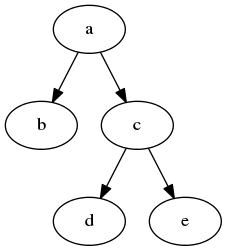Lisp-like tree representation
题目
There is a particular notation for multiway trees in Lisp. Lisp is a prominent functional programming language, which is used primarily for artificial intelligence problems. As such it is one of the main competitors of Prolog. In Lisp almost everything is a list, just as in Prolog everything is a term.
The following pictures show how multiway tree structures are represented in Lisp.

Note that in the "lispy" notation a node with successors (children) in the tree is always the first element in a list, followed by its children. The "lispy" representation of a multiway tree is a sequence of atoms and parentheses '(' and ')', which we shall collectively call "tokens". We can represent this sequence of tokens as a Prolog list; e.g. the lispy expression (a (b c)) could be represented as the Prolog list ['(', a, '(', b, c, ')', ')']. Write a predicate tree_ltl(T,LTL) which constructs the "lispy token list" LTL if the tree is given as term T in the usual Prolog notation.
Example: ?- tree_ltl(t(a,[t(b,[]),t(c,[])]),LTL). LTL = ['(', a, '(', b, c, ')', ')']
As a second, even more interesting exercise try to rewrite tree_ltl/2 in a way that the inverse conversion is also possible: Given the list LTL, construct the Prolog tree T. Use difference lists.
用单元测试描述为:
解题思路
多路树的形态可以被归纳为以下几种:
- 只有一个节点,如下图。这类多路树在Lisp中表示为一个原子
a。

- 除了根节点,还拥有一至多个子树,如下图,这类多路树在Lisp中表示为一个列表,其中第一个原子为根节点,子树紧随其后。而每一棵子树又都是多路树,其形态也属必于1、2两种之一。

所以,我们可以归纳出以下转换规则:
- 若多路树没有子树则转换为
[a],其中[a]为根节点值。 - 若多路树有子树则转换为
['(', a, <subtree1>, <subtree2>, ..., ')'],其中a为根节点值,<subtree1>为第一棵子树转换后的值,为第二棵子树转换后的值,依次类推。subtree的数量与子树数量相同。而子树的转换规则则套用1和2,因为子树都是多路树。
举个例子,给定多路树(a,[(f,[(g,[])]),(c,[]),(b,[(d,[]),(e,[])])])。
- 此多路树拥有子树,套用规则2。先转换子树
- 转换第一棵子树
(f,[(g,[])])- 此树拥有子树,套用规则2。先转换子树
- 转换第一棵子树
(g,[])- 此树没有子树,套用规则1。转换为
[g]
- 此树没有子树,套用规则1。转换为
- 转换第一棵子树
- 拼接转换后的子树和根节点及括号,得到
['(', f, g, ')']
- 此树拥有子树,套用规则2。先转换子树
- 转换第二棵子树
(c,[])- 此树没有子树,套用规则1。转换为
[c]
- 此树没有子树,套用规则1。转换为
- 转换第三棵子树
(b,[(d,[]),(e,[])])- 此树拥有子树,套用规则2。先转换子树
- 转换第一棵子树
(d,[])- 此树没有子树,套用规则1。转换为
[d]
- 此树没有子树,套用规则1。转换为
- 转换第二棵子树
(e,[])- 此树没有子树,套用规则1。转换为
[e]
- 此树没有子树,套用规则1。转换为
- 转换第一棵子树
- 拼接转换后的子树和根节点及括号,得到
['(', b, d, e, ')']
- 此树拥有子树,套用规则2。先转换子树
- 转换第一棵子树
- 拼接转换后的子树和根节点及括号,得到
['(', a, '(', f, g, ')', c, '(', b, d, e, ')', ')']
代码实现:
reduce是Python标准库提供的一个函数式的工具,其声明为:
reduce(function, iterable, initializer)
其功能是将function累积地、从左往右作用于iterable中的每一个元素。
reduce相当于如下代码:
def reduce(function, iterable, initializer=None):
it = iter(iterable)
if initializer is None:
value = next(it)
else:
value = initializer
for element in it:
value = function(value, element)
return value
这𥚃,使用reduce拼接转换后的子树列表。
反过来,也可以从Lisp格式的多路树转换为Python格式多路树。
转换规则为:
- 从列表中取出第一个元素,其若为原子则此树为单一节点多路树。
- 从列表中取出第一个元素,其若为'('则略过取下一个元素为根节点元素。再从剩余列表中解拆出零至多个子树,直至遇到')'。
举个例子,给定以Lisp格式展示多路树的列表['(', 'a', '(', 'f', 'g', ')', 'c', '(', 'b', 'd', 'e', ')', ')']。
- 取出第一个元素为
(,略过,取下一个元素a为根节点值 - 从剩余列表中解析出第一棵子树
- 取出第一个元素为
(,略过,取下一个元素f为根节点值 - 从剩余列表中解析出第一棵子树
- 取出第一个元素为原子(非括号字符),其是一棵仅有一个节点的多路树
(g,[])
- 取出第一个元素为原子(非括号字符),其是一棵仅有一个节点的多路树
- 从剩余列表中取出第一个元素为
),表明已触及多路树的末尾。至此,解析出了多路树(f,[(g,[])])
- 取出第一个元素为
- 从剩余列表中解析出第二棵子树
- 取出第一个元素为原子,其是一棵仅有一个节点的多路树
(c,[])
- 取出第一个元素为原子,其是一棵仅有一个节点的多路树
- 从剩余列表中解析出第三棵子树
- 从剩余列表中取出第一个元素为
(,略过,取下一个元素b为根节点值 - 从剩余列表中解析出第一棵子树
- 取出第一个元素
d是原子,其是一棵仅有一个节点的多路树(d,[])
- 取出第一个元素
- 从剩余列表中解析出第二棵子树
- 取出第一个元素
e是原子,其是一棵仅有一个节点的多路树(e,[])
- 取出第一个元素
- 从剩余列表中取出第一个元素为
),表明已触及多路树的末尾。至此,解析出了多路树(b,[(d,[]),(e,[])])
- 从剩余列表中取出第一个元素为
- 从剩余列表中取出第一个元素为
),表明已触及多路树的末尾。至此,解析出了多路树(a,[(f,[(g,[])]),(c,[]),(b,[(d,[]),(e,[])])])
代码实现: